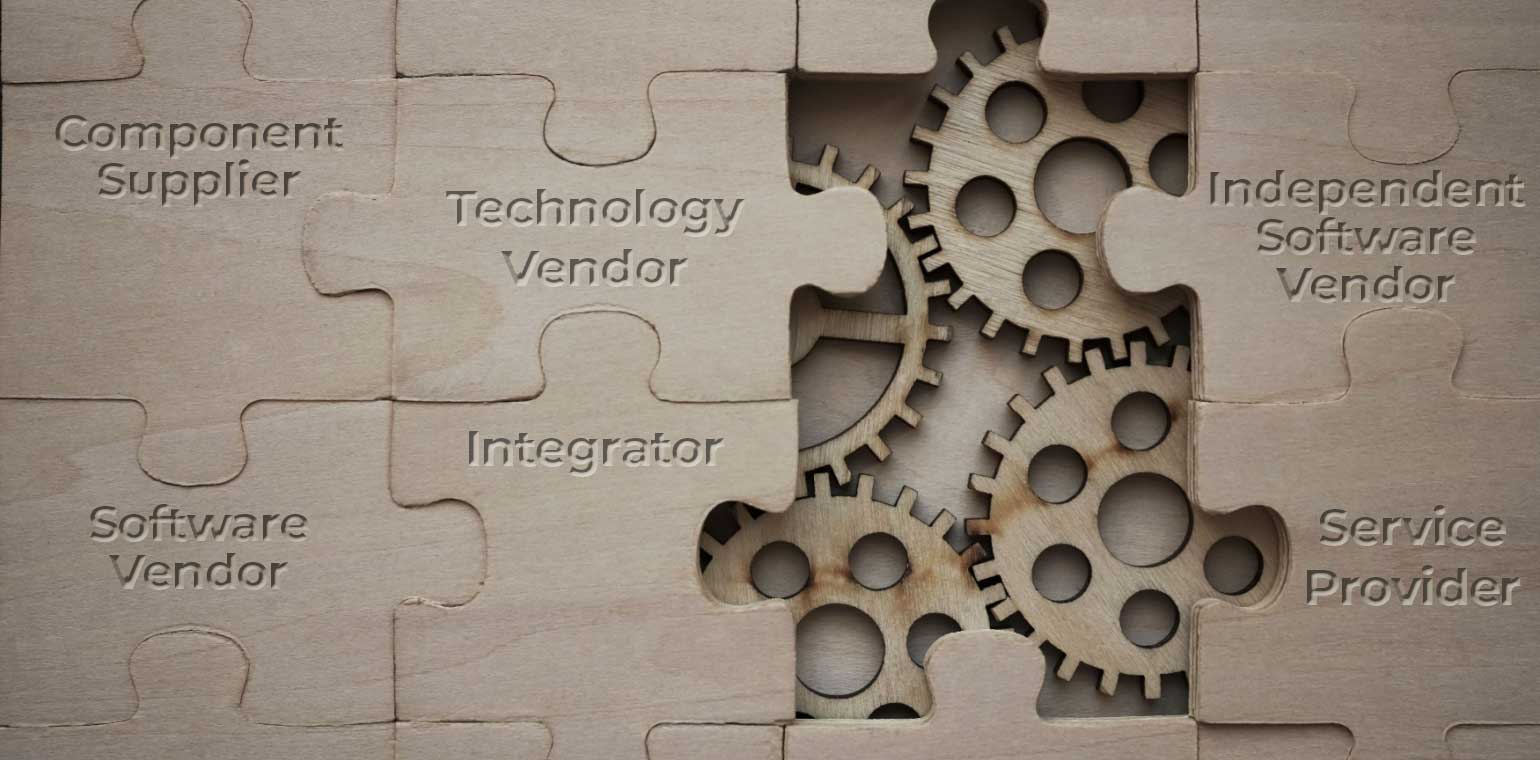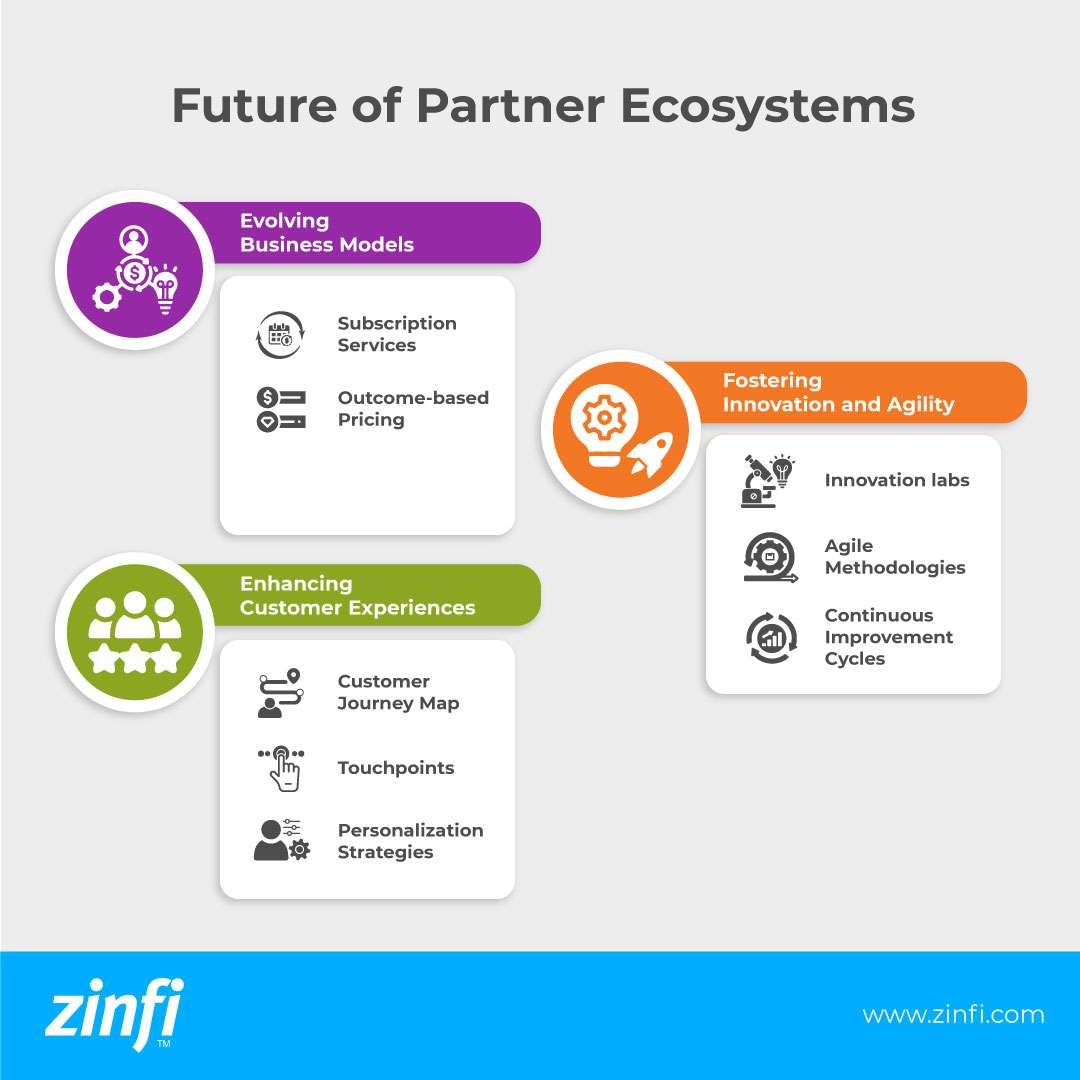Best Practices Articles

The Evolving Partner Ecosystem: Navigating Change and Maximizing Opportunities
The concept of a partner ecosystem is pivotal for businesses aiming to thrive amidst rapid technological advancements and shifting economic landscapes in today's dynamic marketplace. This article explores the nuances of building and leveraging partner ecosystems to drive business success and explores the macro trends, challenges, and opportunities that shape the partner ecosystem landscape.
Understanding the Partner Ecosystem
A partner ecosystem comprises various organizations collaborating to deliver comprehensive solutions and services to customers. This ecosystem includes technology vendors, service providers, integrators, and Independent Software Vendors (ISVs), each playing a crucial role in addressing customer needs. The essence of a flourishing partner ecosystem lies in its ability to adapt to market changes, foster innovation, and deliver seamless customer experiences.
Partner ecosystems are not new, but their significance has grown as businesses increasingly recognize the need for collaboration to stay competitive. In the past, companies might have relied on several strategic partnerships. However, the modern partner ecosystem is far more complex and interconnected, involving various partners that contribute unique value. This interconnected network of partners enables businesses to respond more quickly to market demands and customer needs, fostering a more agile and resilient business environment. Download the Best Practices Guidebook to know more.Key Macro Trends Shaping the Partner Ecosystem
- Accelerating Technological Change
The pace of technological change has never been more frantic. Innovations in Artificial Intelligence (AI), cloud computing, and digital transformation are redefining how businesses operate and interact with customers. The complexity of technology necessitates deeper engagement between partners, vendors, and customers. This interconnectedness is essential to meet the evolving demands of the market.
Technological advancements are not just about keeping up with new tools and software. They involve integrating these technologies to enhance efficiency, reduce costs, and improve customer satisfaction. For instance, AI and machine learning can help automate processes and provide predictive insights, enabling businesses to make more informed decisions and offer personalized services. Cloud computing, on the other hand, offers scalable resources that can support the growing needs of companies without the constraints of traditional IT infrastructure.

Moreover, the rise of technologies such as the Internet of Things (IoT) and blockchain creates new business opportunities and challenges. IoT devices generate massive amounts of data that can be leveraged to improve operations and customer experiences. With its potential to enhance security and transparency, blockchain is being explored for applications ranging from supply chain management to financial transactions. As these technologies evolve, businesses must stay ahead by continuously innovating and adapting their strategies.
- Shifting Demographics and Workforce Dynamics
Changing demographics, particularly in developed countries, impact the labor pool and necessitate increased automation and technological solutions. The aging population and declining birth rates in many regions pose challenges in maintaining a skilled workforce. Companies must leverage their partner ecosystems to access the expertise and resources to navigate these demographic shifts effectively.
The demographic shifts also mean businesses must adapt to different generations' expectations and working styles. For instance, millennials and Gen Z workers prioritize flexibility, work-life balance, and opportunities for professional development. Companies must create work environments aligning with these values to attract and retain talent. Additionally, the growing emphasis on diversity and inclusion requires businesses to build diverse teams that bring various perspectives and ideas.
These demographic changes also necessitate rethinking traditional employment models. With more people working remotely or in gig economy roles, businesses must find ways to integrate these workers into their operations seamlessly. This might involve leveraging technology to enable remote collaboration, offering flexible work arrangements, and creating a culture that values and supports remote and freelance workers.
- Geopolitical Tensions and Supply Chain Disruptions
Geopolitical tensions and supply chain disruptions have highlighted the need for resilient and flexible partner ecosystems. The pandemic-induced disruptions have prompted countries to reconsider their manufacturing capacities and supply chain dependencies. The move towards reshoring and nearshoring is reshaping global supply chains, creating challenges and opportunities for technology companies.
The supply chain disruptions experienced during the pandemic revealed vulnerabilities in global supply chains that many businesses were unprepared for. As a result, there is a growing emphasis on building more resilient and flexible supply chains that can adapt to changing conditions. This includes diversifying suppliers, investing in local manufacturing capabilities, and implementing advanced technologies such as IoT and blockchain to improve transparency and efficiency.
Besides pandemic-related disruptions, geopolitical tensions, such as trade wars and political instability, also impact global supply chains. Businesses must navigate these uncertainties by developing contingency plans and fostering solid relationships with a diverse network of suppliers. By doing so, they can mitigate risks and ensure continuity in their operations, even in the face of geopolitical challenges.
Building a Resilient Partner Ecosystem
Companies must focus on collaboration, innovation, and adaptability to build a resilient partner ecosystem. Here are some key strategies to consider:
- Embracing Collaboration and Shared Goals
Successful partner ecosystems thrive on collaboration and shared goals. Companies must foster a culture of cooperation, where partners work together to deliver integrated solutions. This involves establishing clear communication channels, aligning objectives, and creating mutually beneficial partnerships. Collaboration is essential for a partner ecosystem to meet customer expectations and drive business growth.
Building a collaborative culture requires trust and transparency among partners. This can be achieved through regular communication, joint planning sessions, and shared performance metrics. Additionally, companies should establish governance structures that define roles, responsibilities, and decision-making processes. By creating a framework for collaboration, businesses can ensure that all partners are aligned and working towards common goals.
Technology can play a crucial role in facilitating collaboration. Collaboration platforms, project management software, and communication apps can help partners stay connected and work together more efficiently. By leveraging these tools, businesses can enhance coordination and ensure all partners are on the same page.

- Leveraging Data and Analytics
Data and analytics are crucial in optimizing partner ecosystems. By leveraging data-driven insights, companies can make informed decisions, identify market trends, and enhance operational efficiency. To improve decision-making and deliver personalized customer experiences, it is crucial to integrate data across the ecosystem.
Data analytics can help businesses better understand customer behavior, preferences, and needs. This information can be used to develop targeted marketing campaigns, optimize pricing strategies, and improve product offerings. Additionally, data analytics can help identify inefficiencies in the supply chain, enabling businesses to take corrective actions and improve overall performance. Advanced analytics tools such as AI and machine learning can also provide predictive insights that help companies anticipate market trends and stay ahead of the competition. Learn how artificial intelligence can impact channel sales.
Furthermore, businesses should invest in data integration and management solutions to collect, store, and analyze data from multiple sources. By creating a centralized data repository, companies can ensure all partners can access the information they need to make informed decisions. This can enhance collaboration and drive better outcomes across the partner ecosystem.
- Investing in Partner Enablement
Investing in partner enablement is vital for building a skilled and motivated partner network. This involves providing training, resources, and support to help partners stay updated with the latest technologies and market trends. Partner enablement programs should focus on enhancing technical skills, improving sales capabilities, and fostering innovation.
Effective partner enablement goes beyond traditional training programs. It involves creating a comprehensive support system with access to knowledge resources, technical support, and best practices. Companies should also consider implementing incentive programs that reward partners for achieving specific performance goals. By investing in partner enablement, businesses can build a network of highly skilled and motivated partners who can drive growth and innovation.
In addition, businesses should foster a culture of continuous learning and development within their partner ecosystems. This can be achieved by offering ongoing training opportunities, such as webinars, workshops, and online courses, that help partners stay updated with the latest industry trends and technologies. By promoting a culture of continuous improvement, companies can ensure that their partners are always equipped with the skills and knowledge needed to succeed.
Overcoming Challenges in the Partner Ecosystem
Building and managing a partner ecosystem has challenges despite the benefits. Addressing these challenges requires a strategic approach and a commitment to continuous improvement.
- Navigating Economic Uncertainty
Economic uncertainty, driven by high interest rates and shifting market conditions, poses a significant challenge for businesses, so companies must optimize operations and reduce costs to navigate this uncertainty. This involves leveraging technology to streamline processes, improve efficiency, and mitigate risks.
In economic uncertainty, businesses must be agile and adaptable. This requires a proactive approach to risk management and contingency planning. Companies should regularly assess their financial health, identify potential risks, and develop mitigation strategies. Additionally, businesses should explore new revenue streams and diversification opportunities to reduce dependence on a single market or product.
Effective financial management is crucial for navigating economic uncertainty. Businesses should maintain healthy cash flows, manage expenses, and optimize their capital structure. Doing so can build financial resilience and ensure they are well-positioned to weather economic downturns.
- Addressing Talent Shortages
Talent shortages, particularly in high-skilled areas such as cybersecurity and AI, are a pressing concern for many organizations. Companies must adopt innovative approaches to attract, retain, and develop talent. This includes partnering with educational institutions, investing in employee training, and exploring automation solutions to bridge the skills gap.
To address talent shortages, businesses should focus on creating a positive and inclusive work environment that attracts top talent. This includes offering competitive salaries and benefits, providing opportunities for professional development, and promoting work-life balance. Additionally, companies should invest in training and development programs to upskill existing employees and prepare them for future roles. Partnering with educational institutions can also help businesses access a pipeline of qualified candidates and support the development of industry-specific skills.
Besides traditional hiring strategies, businesses should consider alternative approaches to talent acquisition. This might include leveraging freelance and gig economy workers, exploring global talent pools, and using technology to streamline recruitment. By adopting a flexible and innovative approach to talent management, companies can overcome talent shortages and build a skilled and capable workforce.
- Managing Geopolitical Risks
Geopolitical risks and supply chain disruptions require companies to build resilient and adaptable ecosystems. This involves diversifying supply chains, investing in local manufacturing capabilities, and developing contingency plans for proactively navigating geopolitical uncertainties, which is essential to mitigate risks.
Managing geopolitical risks require a comprehensive understanding of the global landscape and the potential impact of political events on business operations. Companies should regularly monitor geopolitical developments and assess their potential impact on supply chains, market access, and regulatory compliance. Developing contingency plans and diversifying suppliers can help businesses mitigate the risks associated with geopolitical uncertainties. Additionally, companies should engage in scenario planning to explore different outcomes and develop strategies to respond to various scenarios.
Businesses should foster strong relationships with government agencies, industry associations, and other stakeholders. By building a network of supportive partners, companies can gain access to valuable insights and resources that can help them navigate geopolitical risks. Engaging in public policy advocacy and industry forums can also help businesses stay informed and influence policy decisions that impact their operations.
The Future of Partner Ecosystems
The future of partner ecosystems lies in their ability to adapt to changing market dynamics, embrace innovation, and deliver customer value. As technology evolves, companies must stay ahead by leveraging their partner networks to drive growth and innovation.
- Evolving Business Models
Business models are evolving to accommodate the complexities of modern ecosystems. Companies are exploring new revenue streams, such as subscription-based services and outcome-based pricing, and flexibility and agility in adapting business models to changing market conditions to better align with customer needs.
The shift towards subscription-based services reflects recurring revenue models that provide more predictable cash flows and stronger customer relationships. Outcome-based pricing, on the other hand, aligns pricing with the value delivered to customers, creating a win-win situation for both parties. These evolving business models require companies to rethink their sales and marketing strategies, focusing on providing value and building long-term customer relationships.
Additionally, businesses are exploring new ways to monetize their products and services. This might include offering tiered pricing plans, bundling products and services, and leveraging data to create personalized pricing strategies. By adopting innovative business models, companies can better meet the needs of their customers and drive sustainable growth.
- Enhancing Customer Experiences
Delivering exceptional customer experiences is a crucial differentiator in today's competitive landscape. Partner ecosystems must focus on understanding customer needs, providing personalized solutions, and ensuring seamless interactions across all touchpoints. By leveraging customer data and analytics, companies can enhance customer engagement strategies and build long-lasting relationships.
Customer experience is not just about delivering high-quality products and services; it’s about creating memorable interactions that build trust and loyalty. Companies should invest in customer experience management tools and strategies to track interactions, gather feedback, and respond to real-time customer needs. Personalization is also crucial for enhancing customer experiences. Businesses can deliver tailored experiences that meet each customer's unique needs and preferences by leveraging data and analytics.
Furthermore, businesses should focus on creating a seamless omnichannel experience for their customers. This involves integrating online and offline channels, providing consistent and personalized interactions, and ensuring customers can easily navigate different touchpoints. By delivering a cohesive and engaging customer experience, companies can differentiate themselves from their competitors and build stronger customer relationships.
- Fostering Innovation and Agility
Innovation and agility are critical for staying competitive in a rapidly changing market. Companies must foster a culture of innovation within their partner ecosystems, encouraging experimentation and continuous improvement. This involves embracing new technologies, exploring emerging markets, and staying attuned to industry trends.
To foster innovation, businesses should create an environment encouraging creativity and risk-taking. This includes providing employees with the resources and support to experiment with new ideas and technologies. Additionally, companies should establish innovation labs or centers of excellence that focus on developing new products and services. Collaboration with external partners, such as startups and research institutions, can help businesses access new ideas and accelerate innovation.
Agility is crucial for responding to changing market conditions and customer needs. Businesses should adopt agile methodologies to iterate and adapt their strategies quickly. This might involve implementing agile project management frameworks, fostering a culture of continuous improvement, and leveraging data to make informed decisions. By embracing agility, companies can stay ahead of the competition and seize new opportunities.

Conclusion
In conclusion, the partner ecosystem is a dynamic and evolving landscape that requires businesses to adapt, innovate, and collaborate effectively. Companies can build resilient and successful partner ecosystems that drive business growth and deliver exceptional customer experiences by understanding the macro trends, addressing challenges, and leveraging opportunities.
The future of partner ecosystems is bright, with endless opportunities for businesses to innovate, collaborate, and thrive. Companies can build strong and resilient partner ecosystems that drive sustainable growth and success by focusing on collaboration, data-driven insights, and continuous improvement.
Best Practices Guidebook
 The Evolution of PartnerOps: Past, Present & Future Best Practices
The Evolution of PartnerOps: Past, Present & Future Best PracticesDownload Guide
 Mastering Channel Sales: Strategies, Best Practices, and Growth Tactics for 2025
Mastering Channel Sales: Strategies, Best Practices, and Growth Tactics for 2025Download Guide
 Winning with Partner Advisory Councils: Best Practices for Partner Engagement & Growth
Winning with Partner Advisory Councils: Best Practices for Partner Engagement & GrowthDownload Guide
 The Future of Partner Ecosystems Best Practices
The Future of Partner Ecosystems Best PracticesDownload Guide
 The AI Revolution: How Technology and Talent are Shaping the Future
The AI Revolution: How Technology and Talent are Shaping the FutureDownload Guide
 Top 105 Partner Management Metrics that Matter Best Practices
Top 105 Partner Management Metrics that Matter Best PracticesDownload Guide
 Mastering PRM Integration Best Practices
Mastering PRM Integration Best PracticesDownload Guide
 Building a Sales Partner Portal with Salesforce Best Practices
Building a Sales Partner Portal with Salesforce Best PracticesDownload Guide
 Building and Managing Partner Ecosystems Best Practices
Building and Managing Partner Ecosystems Best PracticesDownload Guide
 Mastering Co-Marketing and Co-Selling Best Practices
Mastering Co-Marketing and Co-Selling Best PracticesDownload Guide
 Transforming Partner Ecosystems Best Practices
Transforming Partner Ecosystems Best PracticesDownload Guide
 Mastering Partner Ecosystems Best Practices
Mastering Partner Ecosystems Best PracticesDownload Guide
 Mastering Partner Onboarding Best Practices
Mastering Partner Onboarding Best PracticesDownload Guide
 Partner Ecosystem Management Best Practices
Partner Ecosystem Management Best PracticesDownload Guide
 B2B Marketing in the Age of Intelligence Best Practices
B2B Marketing in the Age of Intelligence Best PracticesDownload Guide
 Multi-Partner Co-Selling Best Practices
Multi-Partner Co-Selling Best PracticesDownload Guide
 A Guide to Enhance Channel Sales Efficiency
A Guide to Enhance Channel Sales EfficiencyDownload Guide
 Mastering Affiliate Marketing Best Practices
Mastering Affiliate Marketing Best PracticesDownload Guide
All Guidebooks







